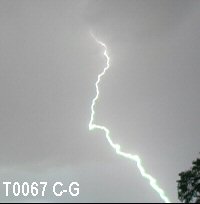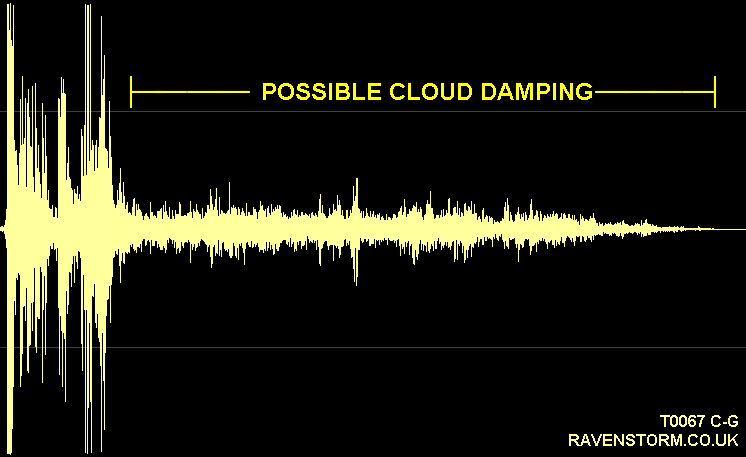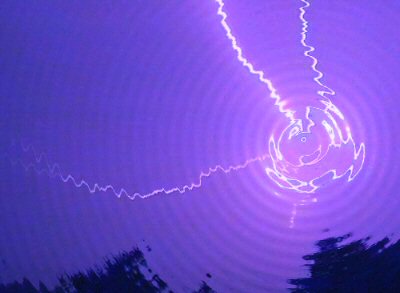You maybe surprised to learn
that thunder is, or at least was, less understood than lightning and tornadoes put together.
We know the end product is a very loud sound wave emerging from the
lightning channel (or any electrical arc), however the intricate process of
its development is somewhat uncertain, and many environmental conditions
need to be considered when listening to the tone and texture of the thunder.
THEORIES
There have been a few theories that have arisen
through history:
Clouds colliding
One of the first theories by Aristotle in the 3rd century BC was
that thunder was the sound of clouds colliding with each other.
Thermal expansion of rain droplets or moisture
An old theory from the 19th century was when a lightning channel cut
through rain or cloud droplets, they exploded into steam creating
sound waves. This has been dismissed after the observation of sound from
electrical arcs in dry air.
Explosion of gaseous chemicals created by the lightning channel
It was also thought also that explosive gaseous chemicals produced by the
arc of lightning were being ignited in turn by the arc and exploding.
Thermal expansion of surrounding air By the mid 19th century it was thought that the superheating of the air
immediately around the lightning channel caused the air to expand leaving a vacuum, and then
collapse immediately with such force that a sound wave radiates from around
the channel.
Thermal expansion of plasma
The more widely accepted theory nowadays, similar to the above theory, is
that the expansion of the plasma (ionised gas) within the lightning channel
itself is the cause of the sound wave. However this theory has not yet been
fully proven.
SPEED DIFFERENCE
Although the shockwave of
thunder occurs at the same time as the lightning, unless the lightning
strikes within 100 metres of where you are, you will always
hear the thunder after the lightning because light travels through the free
atmosphere faster than sound. Typically, light travels at
approximately 186,282 miles (299,791 kilometres) per second in a vacuum
(a fraction slower in air) whereas sound travels at a mere 343 metres per
second (in dry air at 20C) which differs depending on pressure, temperature
and humidity. In this case light works out to be somewhat 866,428 times
faster than sound.
JUDGING DISTANCE
The distance the lightning has occurred can be judged by roughly counting 5
seconds for every mile after the discharge. This is a good generalisation. It is worked out
from knowing that sound travels at approximately 0.215 miles per second at
surface pressure, so after 5 seconds it has travelled 1.075 miles
(approximately 1 whole mile). This is the general rule for cloud-base and
cloud-ground lightning (within the atmospheric boundary layer). But the
speed of sound is dependant on air pressure, humidity and temperature. For
example with upper-level lightning, air pressure is much lower which reduces
speed, the air is dryer which reduces speed, but it is colder which
increases speed, so overall the sound wave could travel at a much slower
speed than normal. This has been linked to anvil lightning, which can be
seen clearly but is so far away and high up its usually silent.
On average thunder is usually inaudible after 10-12 miles of travel
distance, although this depends on the magnitude of the discharge. Distant
rumbles and sub-bass booms may be heard from high-amp lightning more than
15-20 miles away, such as positive flashes (P-Fs).
AMPLITUDE AND TEXTURES OF THUNDER
The sound of thunder can depend on
a number of conditions, such as the air pressure in which it occurs in,
temperature inversions within the atmosphere and orography where mountains
and valleys can cause echoing and modulation of sound. Aside from these
influences, in my personal experience as an thunderstorm observer, it
appears that thunder from different types and intensities of lightning have
their own
different textures and intensities despite the distance at which the
lightning has occurred. It is the general
notion that the closer the lightning is, the louder the thunder. This is
true as sound waves reduce in intensity with distance from the origin
(obeying an inverse-square relationship),
but it also depends on how energetic the lightning channel was. For example the thunder from a
high-energy Cloud-to-Ground (C-G) lightning from a 1-mile distance can be much louder
than a low-energy C-G from half a miles distance.
Lightning varies electrically in amplitude. Most discharges are on average
5,000-30,000 Amperes, but it has been reported to reach in excess of 200,000
Amperes. In one such case the famous strike just before the Apollo 15 launch
in 1971 was measured around the 100,000 Amps mark. The higher the current
the brighter and more energetic the lightning channel, and this generally
follows suit to the amplitude of thunder produced based on the thunderstorms
I have observed.
"High-Amp" lightning,
e.g. C-Gs, P-Fs and organised (channelled) C-Cs / I-Cs can produce loud
thunders featuring bangs, crashes and sonic booms. C-Gs especially tend to
be louder due to the fact they occur close to the ground in higher pressure
environments allowing for a sharper sound propagation.
"Low-Amp" lightning,
e.g. disorganised (broken) C-Cs, I-Cs, C-As and A-Cs (Anvil Crawlers) can produce
softer thunders featuring crackles and rumbles. Also contributing to the
softer thunder is the occurrence of lightning in lower pressure environments
aloft where sound propagation isn't as efficient as at the surface.
Using this fairly crude trend you can judge what type of
lightning may have occurred from the thunder. However there are other reasons why thunder
sounds vary in texture. It can also depend on
the shape of the lightning channel. A fragmented channel with many branches
can produce crackly low-amp thunders whilst a single high-energy channel may
produce bangs and crashes. Sonic booms can also occur freely as sound waves
from different areas of the storm build on top of each other as they overlap
causing increased amplitude, rather in the same way a super-sonic jet
produces a boom as it touches or breaks the speed of sound. Wind-shear and
temperature differences at higher levels could also distort a thunder, similarly to how the
jet sound from a high-altitude plane is
distorted by the time it reaches the ground.
Cloud-Ground (C-G) "Fork"
Thunders
Cloud to Ground (or C-G)
lightning, also known as "fork" lightning, is likely to be the closest anyone will get to a lightning channel
at ground level, and in turn will usually produce the loudest thunder you will hear during a thunderstorm, (unless you
have witnessed an exceptional distant lightning discharge e.g. as seen in
T0011).
In
the low-level atmosphere where the pressure is around 1012mb on average the
sound wave travels very well, and can be
very stunning and pronounced, usually without a "build-up". To double-up a
C-G's thunder-strength, the electrical
discharge often occurs as a high precision channel with minimal branches,
concentrating the current flow down one channel.
High-Amp C-G Example (T0022 mp3)
High-Amp C-G Example
(T0036 mp3)
- Very close double-strike
Mid-Amp C-G Example (T0067 mp3)
Cloud-Cloud (C-C) & Intra-Cloud (I-C) "Sheet"
Thunders
C-C lightning occurs along
the cloud base or between two cells and is the most common type of lightning. It tends to create a softer thunder of
a more crackly nature with strong rumbles. I-C is similar to C-C but occurs
within the cloud and lights it up like a bulb (the type of lightning often
called "sheet"). Some C-Cs and I-Cs may
possess upper-level origins and can be unusually high-amp as observed in
storms such as
T0011
and
T0049, especially during "initiation discharges"
as I like to call them. These
are the first discharges of a thunderstorm's life and have been observed to
be fairly very powerful
in nature.
Ultra High Amp C-C / I-C
Example (T0011 mp3)
- Initiation discharge 8 seconds away (1.6 miles)!! Impressive.
High Amp C-C Example
(T0049 mp3)
Low Amp C-C Example
(T0019 mp3)
- Very close, 1 second away
Very
Low-Amp C-C + High-Amp I-C Example (T0020 mp3)
Positive Flash (P-F) "Anvil Lightning" Thunders
This is the king of all
tropospheric lightning and will produce the biggest thunder sound possible.
However it is quite rare to see at just <5% of all lightning, but some
storms produce more than others given the right conditions. These are on average 5 times the length of a normal
C-G and extending up to the upper-level regions of the cloud from the
ground. During
PS0001 a positive flash struck around 20 miles away, (it took an entire minute and a half for
the thunder to reach me), but the thunder still had a bassy-kick to it and
sounded like a distant fireworks crescendo.
Possible P-F Example (T0021 mp3)
- This singular storm was several miles to the north yet this discharge occurred 2.5 seconds to the
east out of view (0.5 miles away). Due to the nature, position and duration of the thunder and
the immense flash off the roof-tops, it was most likely a 6 mile-long P-F
extending southwards out of the top of the cumulonimbus.
Anvil Crawlers (A-C) & Cloud-Air (C-A)
Thunders
These tend to occur within and
around the upper-level anvil (or towers) of a well-developed strong thunderstorm
cell. A-Cs are
huge, but possess thousands of small branches that distribute the energy
spatially as they "crawl" across the sky. Combined with the nature of how
far up in the atmosphere they occur, along with C-As, you tend to hear a
soft rumble or distant crackles as the thunder from these discharges, sometimes no
thunder at all is observed.
Low Amp C-C + A-C Example (T0024 mp3)
- Mid-level C-C mixed with Anvil Crawlers
MY CLOUD DAMPING
THEORY
Sound is modulated easily by
barriers and mediums (like how sound-proofing works in studio rooms). Have you ever noticed during a
thunderstorm that most thunders, typically close C-Gs and C-Cs, tend to be
loud and sharp for about 3-4 seconds and then quickly become muffled/quiet and
distant in
nature?
I have seen evidence
of C-Gs falling outside rain curtains appearing to produce sharper thunders than those
falling within. Positive anvil strikes are louder in treble for longer than
negative strikes from the base.
Whilst the treble (high-frequency) parts
of sound waves have been shown in experiments to be modulated, and
attenuated by increased humidity, consider also that the damping of these
sounds in studios, or in ear mufflers, is achieved by adding insulation such
as foam, cork or wool. My theory is cloud-droplets and rain curtains should
act as insulation to sound in a similar way to sound-proofing foam.
Therefore the treble should usually be heard from the exposed part of the
bolt only, and not from parts within the cloud or within/behind a dense rain
curtain. Usually only the low-frequencies can penetrate, such as bass booms
and low-rumbles.
I have looked at images of sound waves from C-Gs
I have captured and
I believe I have identified this "cloud damping" effect. See
below.
 A close C-G strike which occurred during
T0067.
A close C-G strike which occurred during
T0067.
Observe the image below of the sound wave of the thunder produced by the
above C-G strike:

CLICK TO HEAR SOUND (mp3 225kb)
The initial sharp rippling of thunder was
observed for 3 seconds before almost immediately reducing in amplitude and
treble to a soft rumble. The nature of the C-G was fairly vertical,
slightly jumping towards the camera, so the
above graph gives a good approximation for the length of the
lightning channel before entering the cloud (about 1000 metres of 3281ft -
about right for this storm). The question that needs asking is if the cloud
wasn't present, would the above graph look the same? It is indeed possible
that the lightning channel began to split up and disperse as it entered the
cloud, and therefore reducing the amplitude.
![]()



